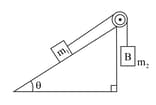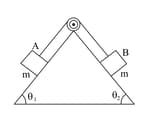NCERT Solutions for Chapter: Laws of Motion, Exercise 2: MCQ-II
NCERT Physics Solutions for Exercise - NCERT Solutions for Chapter: Laws of Motion, Exercise 2: MCQ-II
Attempt the practice questions on Chapter 5: Laws of Motion, Exercise 2: MCQ-II with hints and solutions to strengthen your understanding. NCERT Exemplar Physics - Class 11 solutions are prepared by Experienced Embibe Experts.
Questions from NCERT Solutions for Chapter: Laws of Motion, Exercise 2: MCQ-II with Hints & Solutions
The motion of a particle of mass is given by for for and for . Which of the following statements is true?
In the given figure, the coefficient of friction between the noor and the body is . The coefficient of friction between bodies and is . A force is applied as shown on . the mass of is and of is . Which of the following statements are true?
Mass moves on a slope making an angle with the horizontal and is attached to mass by a string passing over a frictionless pulley as shown in the figure. The co-efficient of friction between and the sloping surface is . Which of the following statements are true?

In given figure, a body of mass slides on a plane inclined at an angle to the horizontal and is the coefficient of friction between and the plane. A is connected by a light string passing over a frictionless pulley to another body also of mass , sliding on a frictionless plane inclined at angle to the horizontal. Which of the following statements are true?

Two billiard ballsand , each of mass and moving in opposite directions with speed of each, collide and rebound with the same speed. If the collision lasts for which of the following statements are true?
A body of mass is acted upon by two perpendicular forces, and The resultant acceleration of the body is
